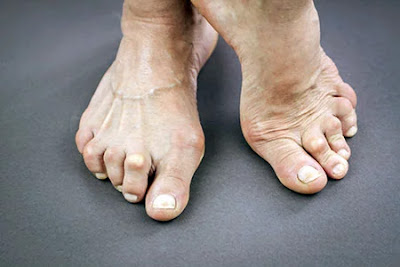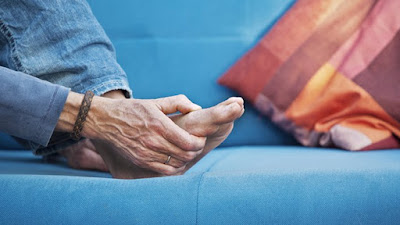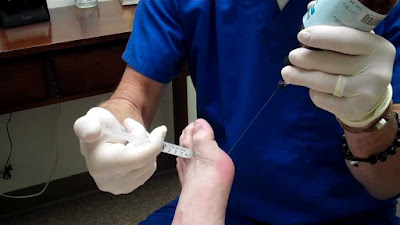F is a condition that affects the joints and causes pain, swelling, and stiffness. It can occur in the toes with several different forms of arthritis causing problems.
In this article, we look at the symptoms of arthritis in the toes, the different types ofarthritis, and how a person can find relief from arthritic pain and discomfort.
Symptoms
Common symptoms of arthritis that affect the toes include:
- Pain: The toe may be particularly painful when it is lifted or when walking, but pain can also occur when at rest in severe cases.
- Stiffness and loss of function: Arthritis can cause an inability to bend the big toe upwards, which can be painful and make it difficult to walk. The toe can become permanently bent downwards and unable to be positioned flat on the floor.
- Swelling and inflammation: This can occur in and around the toe and the joint.
- Formation of a bump: Similar to a bunion or callus, a bump may form from the joints rubbing together.
Other symptoms that can occur in people with arthritis in the toes include:
- muscle aches
- anemia
- fever
- curling of the toes, such as claw toe or hammer toe
- thick, pitted, or separated toenails
- pain elsewhere in the foot
- To compensate for arthritis in the big toe, a person might walk on the outside of their foot, causing pain in the ball of the foot.
Causes
There are different types of arthritis that can cause pain in the toes. These include:
Osteoarthritis (OA) is the most common form of arthritis and causes the cartilage between joints to break down. This allows the joints to rub against each other, causing discomfort and pain.
When OA occurs in the toe, it is often referred to as hallux rigidus, which comes from the Latin for big toe (hallux) and stiffness (rigidus).
OA most commonly occurs in the joint at the bottom of the big toe, which is called the metatarsophalangeal or MTP joint.
Rheumatoidarthritis (RA) is the most common form of inflammatory arthritis. Around 90 percent of people with RA will have foot problems. It can affect several small joints in the foot at the same time, including those in the toes.
Gout
Gout is a form of arthritis that occurs when uric acid crystals form deposits in and around the joints. Uric acid is a bodily waste product in the bloodstream.
Psoriatic arthritis
Psoriatic arthritis (PA) is arthritis associated with the autoimmune disease known as psoriasis. In most cases, joint problems develop after the skin condition, although occasionally it happens in the reverse order. PA is known to affect the toes.
Infectious arthritis
Arthritis can be caused by an infection within the joint. This type is often the result of bacteria traveling through the bloodstream, although it can also be caused by a virus or fungus. The small joints in the feet can be affected.
Home remedies
If a person is concerned that they may have arthritis in their toes, they should see a doctor, as soon as possible. Arthritis is easier to treat when steps are taken early in the disease to slow its progression.
However, there are several things a person can do at home to relieve the symptoms ofarthritis in the toes. These include:
- using ice packs to reduce inflammation
- wearing stiff-soled shoes with room for the toes
- not wearing high heeled shoes
- bathing the feet in a contrast bath
To use a contrast bath, a person places the affected foot in a bucket of cold water for 30 seconds, and then in a bucket of warm water for 20 seconds, alternating between buckets for 5 minutes. This can be done up to three times a day, but a person should take care to avoid freezing or scalding water.
Medical treatment
In some cases, medical intervention is needed to treat arthritic pain in the toes. Treatment may include:
- Painkillers or anti-inflammatory medication, which can reduce short-term pain and discomfort.
- Steroid injections, which may be given to reduce inflammation. The injection site may be painful for a few days following the procedure, but improvement can be permanent.
- Surgery to trim, reshape, or replace the bone in the joint.
There are three main types of surgery that could be used to help a person with arthritis in the toes. These are:
Cheilectomy
A cheilectomy is most commonly used when damage to the toe is mild or moderate. An incision is made, and parts of the bone are removed so that the toe can move more freely.
The toe may remain swollen for several months, but most people experience long-term relief.
Improvement is permanent in around 75 percent of people. In some cases, a person’sarthritis may continue to worsen, and another operation may be required.
Arthrodesis
Also known as fusion, arthrodesis is when the bones are fused together in a permanent position, using pins, screws, or a plate.
The toe will not move again, but arthrodesis is the most reliable way of treating severe pain, with a success rate of around 95 percent.
Arthroplasty
In arthroplasty, the joint surfaces are removed and replaced with an artificial joint. This procedure is more common for older people who may not need to be as physically active as someone younger.
Prevention
While arthritis in the toes is not always preventable, there are some simple lifestyle changes a person can make to reduce their risk of the condition. These include:
- engaging in regular exercise
- wearing comfortable well-fitting shoes
- losing weight if overweight
Outlook
The outlook for arthritis in toes varies depending on the type of arthritis.
In most cases of OA in the toes, the toe will stiffen but may not get any worse, even after 20 years with the condition. In around 20 to 25 percent of cases, it will get worse and require treatment.
In cases of RA, 1 in 20 people will have severe damage to the joints. In contrast, only 1 in 5 people with RA affecting the toes will have problems worse than pain and stiffness.




